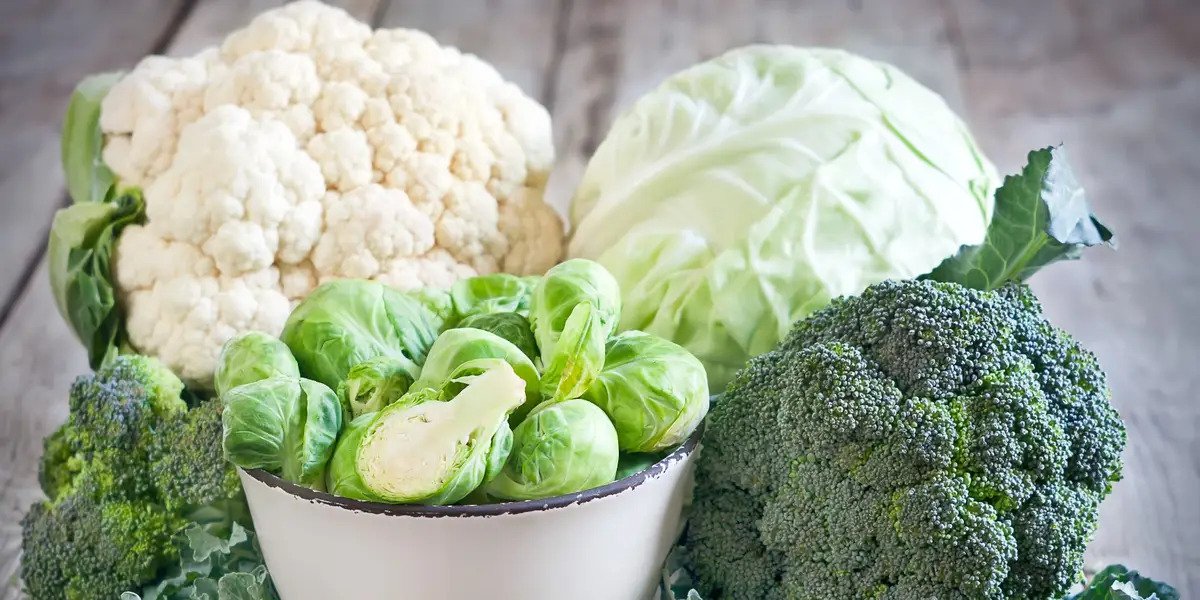Home>Gardening News and Trends>Latest News>Which Vegetables Are The Best For You


Latest News
Which Vegetables Are The Best For You
Modified: January 22, 2024
Discover the Latest News about the Best Vegetables for Your Health. Find out which vegetables pack the most nutritional punch and improve your well-being.
(Many of the links in this article redirect to a specific reviewed product. Your purchase of these products through affiliate links helps to generate commission for Chicagolandgardening.com, at no extra cost. Learn more)
Table of Contents
Introduction
Welcome to the world of vegetables! With their vibrant colors, delicious flavors, and numerous health benefits, vegetables are an essential part of any balanced diet. Whether you’re a devoted vegetarian or simply looking to incorporate more plant-based foods into your meals, knowing which vegetables are the best for you can help optimize your nutritional intake.
Vegetables are packed with essential vitamins, minerals, and antioxidants that promote overall health and well-being. They contribute to weight management, heart health, and even help reduce the risk of chronic diseases like diabetes and certain types of cancer.
In this article, we will explore a variety of vegetable categories and highlight some of the standout options in each group. From leafy greens to root vegetables, cruciferous to allium varieties, we’ll uncover the nutritional benefits and unique characteristics of these vegetables, providing you with the knowledge to make informed choices and enjoy a diverse and nutrient-rich diet.
As you dive into the world of vegetables, remember that incorporating a variety of colors and types into your meals is key. Each vegetable group offers its own set of nutritional advantages, so embracing diversity is vital to reaping the full benefits of these plant-based powerhouses.
So, let’s embark on this vegetable adventure together and discover which vegetables are the best for you!
Leafy Green Vegetables
Leafy green vegetables are known for their vibrant green hues and are a nutritional powerhouse packed with vitamins, minerals, and fiber. They are low in calories and high in nutrients, making them an excellent choice for maintaining a healthy diet.
One popular leafy green vegetable is spinach. This versatile vegetable is rich in iron, which is essential for producing red blood cells and maintaining energy levels. Additionally, spinach contains vitamins A, C, and K, as well as folate and calcium.
Kale is another leafy green that has gained popularity in recent years. It is one of the most nutrient-dense vegetables and is an excellent source of vitamins A, C, and K. Kale also contains antioxidants and is known for its potential anti-inflammatory properties.
Swiss chard is a leafy green vegetable that offers a unique flavor and an array of health benefits. It is high in vitamins A, C, and K, as well as potassium and magnesium. Swiss chard is also a good source of antioxidants that may help protect against chronic diseases.
Other leafy green vegetables that are worth mentioning include arugula, collard greens, and romaine lettuce. Arugula is a peppery-tasting green that is rich in vitamin K and folate. Collard greens are dense in nutrients like vitamin C, vitamin K, and calcium. Romaine lettuce is a crisp and refreshing option that provides ample amounts of vitamins A, K, and C.
Leafy green vegetables are incredibly versatile and can be enjoyed in various ways. They can be added to salads, sautéed as a side dish, or even blended into smoothies for an added nutritional boost.
Incorporating leafy green vegetables into your diet can help support healthy digestion, improve immune function, and reduce the risk of chronic diseases. So, don’t hesitate to stock up on these nutritious greens and enjoy their numerous health benefits!
Cruciferous Vegetables
Cruciferous vegetables are a family of vegetables that boast a unique combination of flavors and incredible health benefits. These vegetables get their name from the cross-shaped pattern of their flowers, and they are renowned for their cancer-fighting properties.
One well-known cruciferous vegetable is broccoli. This green vegetable is loaded with essential nutrients, including vitamin C, vitamin K, and folate. Broccoli is also a great source of fiber, which promotes healthy digestion, and is rich in antioxidants that help combat oxidative stress in the body.
Cauliflower is another versatile cruciferous vegetable that offers numerous health benefits. It is an excellent source of vitamin C, which plays a crucial role in immune function. Cauliflower is also low in calories and carbohydrates, making it a great choice for those watching their weight or following a low-carb diet.
Brussels sprouts are miniature cabbages and are packed with essential nutrients. They contain high amounts of fiber, vitamin C, and vitamin K. Brussels sprouts also contain antioxidants and compounds that have been shown to have anti-inflammatory and cancer-fighting properties.
Kale, while also mentioned in the leafy green section, belongs to the cruciferous vegetable family as well. This superfood is rich in vitamins A, C, and K, and it provides numerous health benefits, including promoting eye health and supporting bone health.
Other cruciferous vegetables worth mentioning include cabbage, bok choy, and radishes. Cabbage is low in calories and high in fiber, making it a great addition to salads or stir-fries. Bok choy is packed with vitamins A, C, and K, and it adds a unique flavor and texture to stir-fries and soups. Radishes are crunchy and refreshing, and they are a good source of vitamin C, potassium, and fiber.
By incorporating cruciferous vegetables into your meals, you can benefit from their powerful antioxidants, anti-inflammatory properties, and potential cancer-fighting effects. These vegetables not only add flavor and texture to your dishes but also provide a wide range of nutrients that contribute to overall health and well-being.
Root Vegetables
Root vegetables are an underground treasure trove of nutrients and flavors. These vegetables grow beneath the surface of the ground and come in a variety of shapes, sizes, and colors. They are excellent sources of carbohydrates, fiber, and essential vitamins and minerals.
One popular root vegetable is the carrot. Carrots are known for their vibrant orange color and are packed with beta-carotene, a pigment that the body converts into vitamin A. They are also rich in antioxidants and provide a good source of vitamins C and K.
Sweet potatoes are another beloved root vegetable that offers a natural sweetness and a host of health benefits. They are high in fiber and contain an abundance of vitamins and minerals, including vitamin A, vitamin C, and potassium. Sweet potatoes also contain antioxidants that are essential for fighting inflammation in the body.
Beets are root vegetables known for their deep red color and earthy flavor. They are rich in nitrates, which have been shown to have positive effects on blood pressure and athletic performance. Beets also contain high levels of folate, manganese, and vitamin C, making them a nutrient-dense choice.
Parsnips are often considered the unsung heroes of root vegetables. They resemble white carrots but have a slightly sweeter taste. Parsnips are an excellent source of fiber, vitamin C, and potassium. They also provide important antioxidants and can be used in a variety of dishes, such as soups, stews, and roasted vegetable medleys.
Other noteworthy root vegetables include turnips, rutabagas, and radishes. Turnips are low in calories and provide a good amount of fiber and vitamin C. Rutabagas, often mistaken for turnips, are a cross between a cabbage and a turnip. They are rich in nutrients like vitamin C, potassium, and fiber. Radishes come in various colors and shapes and are crunchy and refreshing. They are a good source of vitamin C, folate, and fiber.
Root vegetables offer an array of flavors, textures, and vibrant colors, making them a versatile and nutritious addition to your meals. Incorporating these vegetables into your diet provides an excellent source of energy, nourishment, and essential nutrients.
Nightshade Vegetables
Nightshade vegetables are a group of vegetables from the Solanaceae family that have been a part of human diets for centuries. While they offer a range of health benefits, some individuals may be sensitive to certain compounds found in nightshade vegetables, such as solanine and capsaicin.
Tomatoes are one of the most well-known nightshade vegetables. They are rich in vitamin C and antioxidants, including lycopene, which has been linked to reducing the risk of certain cancers. Tomatoes are also a good source of vitamins A, B, and K, as well as potassium.
Peppers, including bell peppers and chili peppers, are also part of the nightshade vegetable family. Bell peppers come in various colors and are packed with vitamin C and other antioxidants. Chili peppers contain capsaicin, a compound that provides a spicy kick and has potential metabolism-boosting and pain-relieving properties.
Eggplants are another common nightshade vegetable. They are low in calories and provide dietary fiber, vitamins, and minerals. Eggplants also contain antioxidants, such as nasunin, which may help protect against cellular damage.
Potatoes are known for their versatility and widespread consumption worldwide. They provide carbohydrates, vitamin C, and potassium. While potatoes can be a nutritious addition to a well-rounded diet, it’s essential to be mindful of cooking methods, as deep-frying can add excess calories and unhealthy fats.
Goji berries, although not as commonly recognized as other nightshade vegetables, are part of the Solanaceae family. These small, red berries are packed with antioxidants, vitamins, and minerals. Goji berries are often dried and used in various culinary preparations or enjoyed on their own as a healthy snack.
It’s worth noting that while nightshade vegetables offer many health benefits, some individuals with specific health conditions, such as arthritis or digestive issues, may choose to limit or avoid consuming them. It’s best to consult with a healthcare professional to determine if any dietary adjustments are necessary.
For most people, nightshade vegetables can be enjoyed as part of a balanced diet. They add flavor, variety, and a range of essential nutrients to meals, making them a valuable addition to any culinary repertoire.
Allium Vegetables
Allium vegetables belong to the Allium genus and are known for their distinct aroma and flavor. These vegetables are packed with essential nutrients and offer a wide range of health benefits.
One popular allium vegetable is garlic, which is widely used in various cuisines around the world. Garlic is not only known for its pungent taste but also for its potential health benefits. It contains a compound called allicin, which has been shown to have anti-inflammatory and antimicrobial properties. Garlic is also rich in vitamin C, vitamin B6, and manganese.
Onions are another staple in many households. They come in various colors and flavors, such as white onions, red onions, and sweet onions. Onions are rich in antioxidants and contain a compound called quercetin, which has been linked to reducing inflammation and promoting heart health. They are also a good source of vitamin C, vitamin B6, and dietary fiber.
Shallots are closely related to onions and garlic and are widely used in cooking. They have a sweeter and milder flavor compared to onions. Shallots are a good source of vitamins A and C, as well as potassium and iron.
Leeks, with their mild onion-like flavor, are often used in soups and stews. They are a good source of vitamin K, vitamin C, and folate. Leeks also provide dietary fiber and contain important antioxidants.
Chives are tiny, green herbs with a delicate onion flavor. They are commonly used as a garnish or added to dishes for a burst of freshness. Chives are loaded with vitamins A and C and contain minerals like potassium and calcium.
Allium vegetables not only add flavor to dishes but also contribute to overall health and well-being. Their sulfur-containing compounds have been associated with potential cancer-fighting properties and cardiovascular benefits.
By incorporating allium vegetables into your meals, you can benefit from their unique flavors, nutrient profiles, and potential health-promoting properties. Whether you enjoy them raw, sautéed, roasted, or incorporated into your favorite recipes, allium vegetables are a valuable addition to a diverse and nutritious diet.
Legumes
Legumes are a diverse group of plants that include beans, lentils, peas, and chickpeas. They are not only tasty and versatile but also packed with protein, dietary fiber, vitamins, and minerals.
One popular legume is the black bean. Black beans are an excellent source of plant-based protein, making them a great option for vegetarians and vegans. They are also high in fiber, which aids digestion and helps regulate blood sugar levels. Black beans are rich in antioxidants and contain essential minerals like iron, magnesium, and potassium.
Lentils are another fantastic legume that comes in various colors, including green, red, and yellow. They are an excellent source of plant-based protein and dietary fiber. Lentils are also packed with folate, iron, and other essential minerals. They cook quickly and can be used in a variety of recipes, from soups and stews to salads and side dishes.
Chickpeas, also known as garbanzo beans, are a staple in many Mediterranean and Middle Eastern cuisines. They are versatile legumes that can be used to make hummus, added to salads, or roasted for a crunchy snack. Chickpeas are rich in protein, dietary fiber, and several vitamins and minerals, including folate, manganese, and iron.
Peas, whether green peas or split peas, are nutrient-dense legumes. They are a good source of plant-based protein and dietary fiber. Peas also provide vitamins A, C, and K, as well as minerals like potassium and iron. Green peas can be enjoyed fresh or frozen, while split peas are often used in soups and stews after being dried and split.
Other legumes worth mentioning include kidney beans, navy beans, and soybeans. Kidney beans are rich in protein, dietary fiber, and a variety of vitamins and minerals. Navy beans are small, white legumes that are commonly used in soups, baked beans, and chili. Soybeans are unique among legumes as they are a complete source of protein, meaning they provide all the essential amino acids our bodies need.
Adding legumes to your diet can provide numerous health benefits, including improved heart health, blood sugar control, and weight management. They are an economical and environmentally friendly source of nutrients and can be used in a wide range of dishes to enhance both flavor and nutritional value.
Cucurbitaceae Vegetables
Cucurbitaceae vegetables, also known as gourd vegetables, belong to the Cucurbitaceae family. These vegetables are characterized by their fleshy interiors and hard rinds. They come in various shapes, sizes, and colors and offer an array of flavors and textures.
One popular cucurbitaceae vegetable is the cucumber. Cucumbers are refreshing and hydrating, with a high water content. They are low in calories and provide important vitamins and minerals, including vitamin K and potassium. Cucumbers can be enjoyed raw in salads, as a crunchy snack, or even pickled for added flavor.
Zucchini, also known as courgette, is another versatile cucurbitaceae vegetable. It has a mild flavor and a tender texture, making it a popular choice in many dishes. Zucchini is low in calories and rich in nutrients like vitamin C, vitamin B6, and potassium. It can be grilled, sautéed, spiralized into “zoodles,” or used in baked goods for added moisture and nutrition.
Butternut squash is a winter squash that offers a sweet and nutty flavor. It is an excellent source of vitamin A, providing high levels of beta-carotene. Butternut squash is also rich in fiber, vitamin C, and potassium. It can be roasted, pureed into soups, or used as a healthy alternative to pasta in dishes like butternut squash noodles.
Watermelon is a unique member of the cucurbitaceae family. While it is mostly known for its deliciously sweet and juicy flesh, the rind and seeds are also edible and nutrient-rich. Watermelon is hydrating, as it contains a high water content. It is a good source of vitamins A and C and provides hydration and essential electrolytes.
Other cucurbitaceae vegetables include pumpkin, cantaloupe, and bitter gourd. Pumpkin is a versatile vegetable that offers an abundance of vitamin A, fiber, and antioxidants. Cantaloupe is a sweet melon that is packed with vitamins A and C, and it provides hydration and electrolytes. Bitter gourd, also known as bitter melon, has a bitter taste but is valued for its potential health benefits, including blood sugar regulation and antioxidant properties.
Cucurbitaceae vegetables are incredibly versatile and can be enjoyed in both sweet and savory dishes. They are not only delicious but also provide a range of essential nutrients, making them a valuable addition to a well-balanced diet.
Solanaceae Vegetables
Solanaceae vegetables, also known as nightshade vegetables, belong to the Solanaceae family, which includes a variety of delicious and nutritious plants. While these vegetables offer an array of health benefits, some individuals may have sensitivities to certain compounds found in nightshade vegetables.
One popular solanaceae vegetable is the tomato. Tomatoes are rich in vitamins A and C, as well as antioxidants like lycopene. Lycopene has been associated with reducing the risk of certain cancers and promoting heart health. Tomatoes can be enjoyed raw in salads, cooked into sauces, or roasted for a burst of flavor.
Peppers, including bell peppers and chili peppers, are another well-known solanaceae vegetable. Bell peppers are a great source of vitamin C and provide a range of antioxidants. They come in various colors, such as green, red, yellow, and orange, each offering its unique flavor profile. Chili peppers contain capsaicin, a compound that provides heat and potential health benefits, including pain relief and metabolism boosting properties.
Eggplants are another popular solanaceae vegetable, known for their smooth texture and unique flavor. They are low in calories and carbohydrates, making them a great choice for those watching their weight. Eggplants are rich in fiber and antioxidants, including nasunin, which has been linked to protecting against cellular damage.
Potatoes, although not as commonly associated with the solanaceae family, are part of it. Potatoes are one of the world’s most widely consumed vegetables and provide important nutrients like vitamin C, potassium, and fiber. They are versatile and can be boiled, baked, mashed, or fried for various culinary creations.
Goji berries, often used in dried form, are another member of the solanaceae family. They are a nutrient-dense fruit and are rich in antioxidants, vitamins, and minerals. Goji berries are commonly enjoyed as a snack or added to smoothies, oatmeal, or trail mixes for an extra nutritional boost.
While solanaceae vegetables offer a range of flavors and health benefits, it’s worth noting that some individuals with specific health conditions may choose to limit or avoid consuming them. If you have concerns or specific dietary requirements, it is best to consult with a healthcare professional.
Solanaceae vegetables can be a delicious and nutritious addition to a well-balanced diet. They provide essential nutrients, antioxidants, and flavors that can enhance a variety of dishes. Whether roasted, grilled, sautéed, or enjoyed in their raw form, solanaceae vegetables can bring a burst of taste and nutrition to your meals.
Miscellaneous Vegetables
While many vegetables fit nicely into specific categories, there are some that don’t quite fit the traditional mold. These miscellaneous vegetables offer their unique flavors, textures, and nutrients, adding diversity to our plates and providing a range of health benefits.
One such vegetable is asparagus. Asparagus is a nutrient-dense vegetable that is particularly rich in vitamins A, C, and K. It also provides essential minerals like folate and iron. This versatile vegetable can be steamed, roasted, grilled, or sautéed, and adds a delightful crunch and flavor to various dishes.
Cauliflower, although mentioned earlier in the cruciferous vegetable section, is worth mentioning here as well. This versatile vegetable can be transformed into a nutritious rice substitute, mashed as a creamy side dish, or even used as a pizza crust. Cauliflower is low in calories and carbohydrates while offering a good amount of fiber and several vitamins and minerals.
Artichokes are a unique vegetable that may seem daunting to prepare, but they are worth the effort. They are packed with fiber, vitamins, and minerals and are renowned for their potential liver-protective properties. Artichokes can be steamed, roasted, or stuffed and make an elegant addition to any meal.
Okra is a lesser-known vegetable that is popular in Southern cuisine and various international dishes. It is high in fiber and contains essential vitamins and minerals, including vitamins A and C, magnesium, and potassium. Okra can be added to stews, stir-fries, or even pickled for a tangy snack.
Spinach, although mentioned earlier in the leafy green vegetable section, deserves a spot here as well. This nutrient-packed vegetable is loaded with vitamins A, C, and K, as well as folate and iron. Spinach can be enjoyed raw in salads, sautéed as a side dish, or blended into smoothies for an added nutritional boost.
Other miscellaneous vegetables worth mentioning include celery, fennel, and mushrooms. Celery is low in calories and provides fiber, vitamins, and minerals. Fennel offers a unique licorice-like flavor and is a good source of vitamin C and fiber. Mushrooms are a versatile vegetable that adds umami flavor to dishes and provides essential nutrients like B vitamins and antioxidants.
Including a variety of miscellaneous vegetables in your diet not only adds deliciousness and visual appeal to your meals but also ensures that you receive a wide range of nutrients and health benefits. So, don’t be afraid to venture beyond the usual vegetable choices and explore the wonderful world of these diverse and nutritious options.
Conclusion
Vegetables are truly nature’s gift, providing us with a plethora of colors, flavors, and incredible health benefits. From leafy greens like spinach and kale to cruciferous vegetables like broccoli and cauliflower, the world of vegetables is diverse and abundant.
Root vegetables like carrots and sweet potatoes offer grounding nourishment, while nightshade vegetables like tomatoes and peppers add a tantalizing burst of flavor. Allium vegetables like onions and garlic bring depth and aroma to our dishes, while legumes like beans and lentils offer plant-based protein and fiber.
Let’s not forget about the cucurbitaceae family, with versatile vegetables like cucumber and zucchini, or the solanaceae family, which includes tomatoes, peppers, and eggplants. And of course, there are the miscellaneous vegetables like asparagus, cauliflower, and artichokes, each with its own unique qualities and benefits.
To truly optimize our health, it is essential to embrace a diverse range of vegetables in our diets. By doing so, we provide our bodies with the essential vitamins, minerals, antioxidants, and fiber they need to thrive. Each vegetable category offers its own set of nutritional advantages and should be celebrated for the nourishment it provides.
So, whether you’re piling your plate high with leafy greens, experimenting with new recipes featuring cruciferous vegetables, or savoring the flavors of nightshade, allium, and other miscellaneous vegetables, you’re on the right track to a healthier, more vibrant life.
Remember to indulge in a rainbow of vegetables, incorporating them into your meals in creative and delicious ways. Whether you’re a dedicated vegetarian, a flexitarian, or simply looking to incorporate more plant-based foods into your diet, vegetables should be the stars of your plate.
So go ahead, explore the world of vegetables, discover new flavors, and embrace the incredible health benefits they offer. Your body will thank you, and you’ll find yourself on a delicious journey to optimal well-being.










